Apple Mac Mini M4 Performance
To be fair, most of our benchmarks are for Windows and Linux. Still, let us start with Geekbench 6 a common cross-platform benchmark that works reasonably well at these low core counts.
GeekBench 6 CPU Performance
First, we wanted to discuss the CPU performance of the new Mac Mini using Geekbench 6.
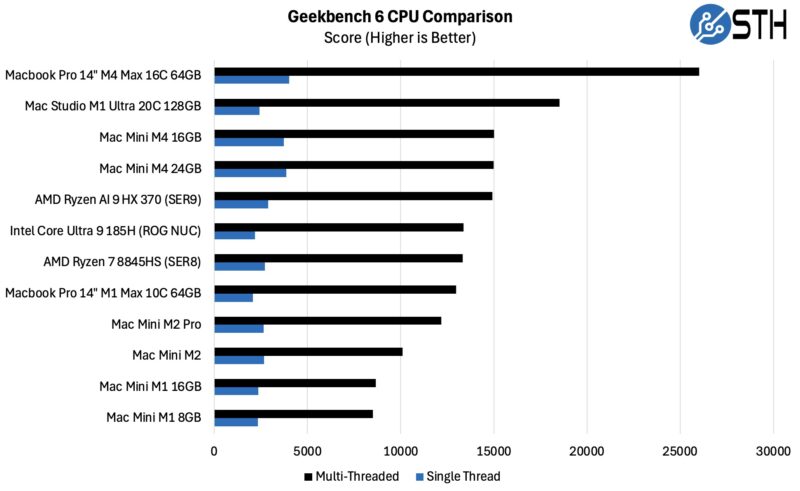
That is a bit hard to read, so we are going to split out the multi-threaded and single threaded workloads and sort by multi-threaded.
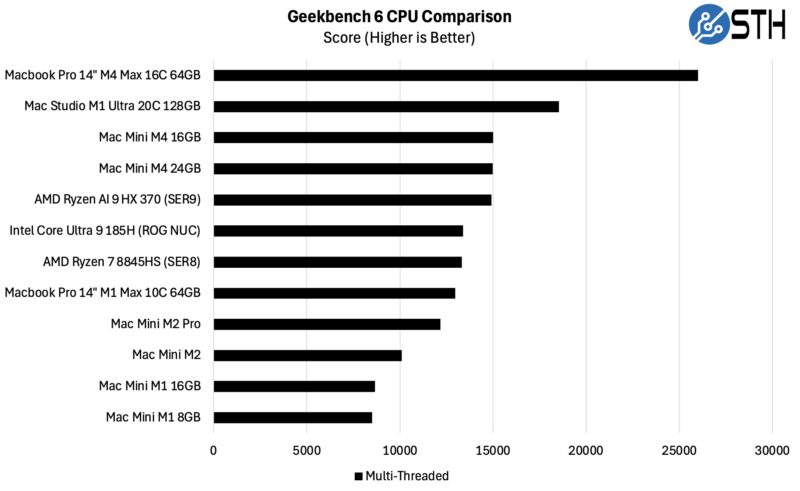
The Mac Mini M4 is really good, but there is not a CPU speed-up with the 24GB model. That is what we would expect. Geekbench 6 is not designed for testing high memory capacities nor is it particularly great at multi-threaded workloads. Still, here you can see the 14″ Macbook Pro M4 Max is really good. It makes the Mac Studio M1 Ultra fairly redundant, especially since it is portable.
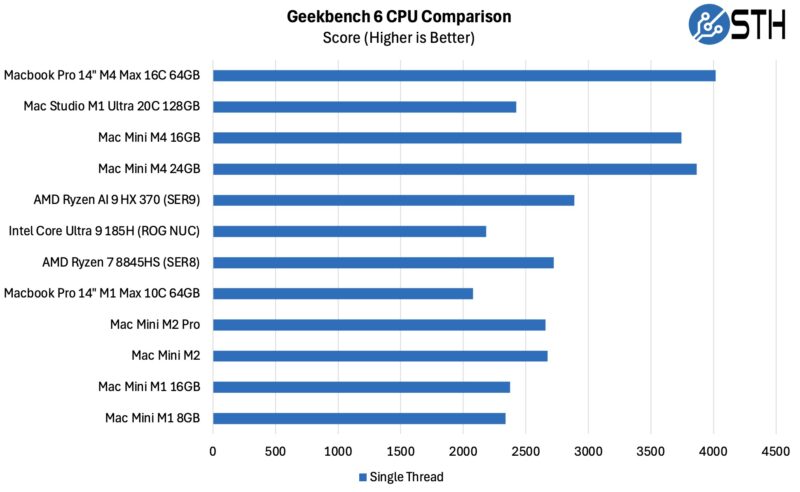
We kept the same sort just so things did not move. The key here is that Apple’s performance cores do really well on Geekbench. We were very close on the multi-threaded results between the Mac Mini M4 and the Beelink SER9 with the AMD Ryzen AI 9 HX 370. At the same time in the single threaded results, the M4 does really well.
Moving to the GPU side, we are going to focus on OpenCL here.
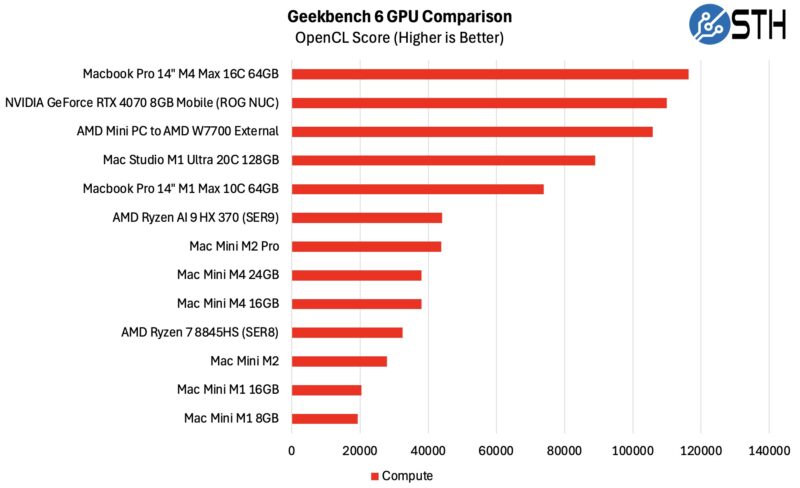
Perhaps the big note is that the newer AMD Ryzen AI 9 HX 370 can actually outpace not just the base Mac Mini M4 here, but also the M2 Pro with the bigger GPU. Of course, we are using OpenCL, so the Metal results are much higher for Apple, but we wanted a Windows comparison using integrated and dGPUs.
On the dGPU side, we have the ASUS ROG NUC with the NVIDIA RTX 4070 notebook edition in here, as well as the AMD Radeon Pro W7700. The W7700 we have tested both in the Beelink GTi12 Ultra and via Oculink in Minisfourm UM890 Pro and the results are very similar between the two. The M4 Max is delivering performance in-line with a RTX 4070 8GB notebook dGPU or a AMD Radeon Pro W7700 in OpenCL. Metal, of course, is faster.
Probably the biggest takeaway there is just that Apple is scaling its GPU cores with its CPU. If we look at AMD and Intel, they are trying to sell you PCIe GPUs instead. When you go from a Ryzen AI 9 HX 370 to an AMD Ryzen 7 9800X3D, for example, AMD decreases the onboard GPU. In the Apple realm, as your CPU scales, your GPU scales as well. AMD’s approach is better for things like adding an NVIDIA RTX 6000 Ada or a GeForce RTX 4090. Apple’s approach seems better for battery life. Imagine if AMD and Intel left PCIe GPUs to the realm of Threadripper and Xeon W workstations.
Our Adobe Creative Cloud Workflows
There were a few more workflows that we wanted to try. These are not the typical Puget Bench workflows. Instead, they are ones that we run all of the tiem on Apple Silicon. For example, the recent AMD EPYC 9005 Turin video had a last minute add that I needed to render before walking into the keynote so we are using that as our project file. We also have a workflow hitting Lightroom and Photoship and Excel on this one as a script that is generating the image and video assets for a big launch piece like that.
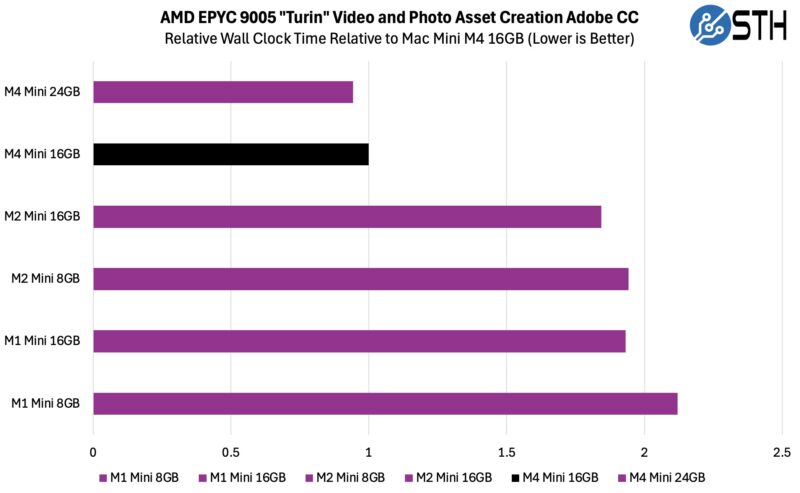
Looking at the M1 Max versus the M4 Max since that is more realistic for us and this is something that happened to me about a month and a half ago.
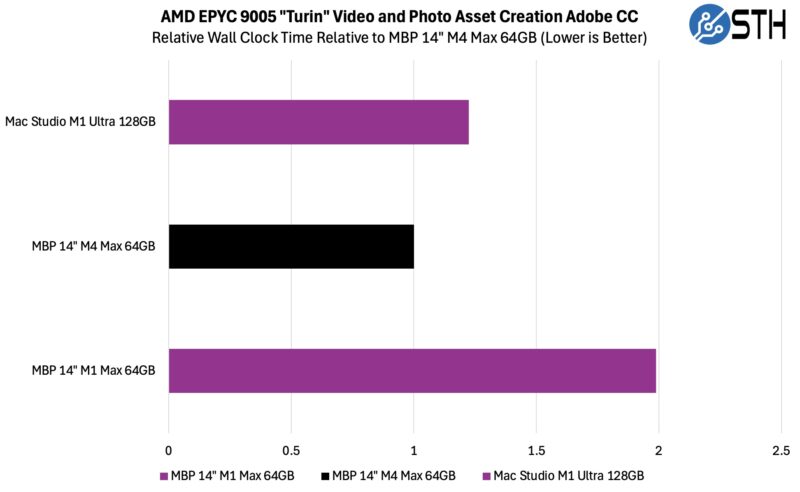
For the recent xAI Colossus 100,000 GPU data center tour we had to do some audio fixing which required us to geenrate captions. We had to transcode the video then we used the OpenAI Whisper.ai to generate captions.
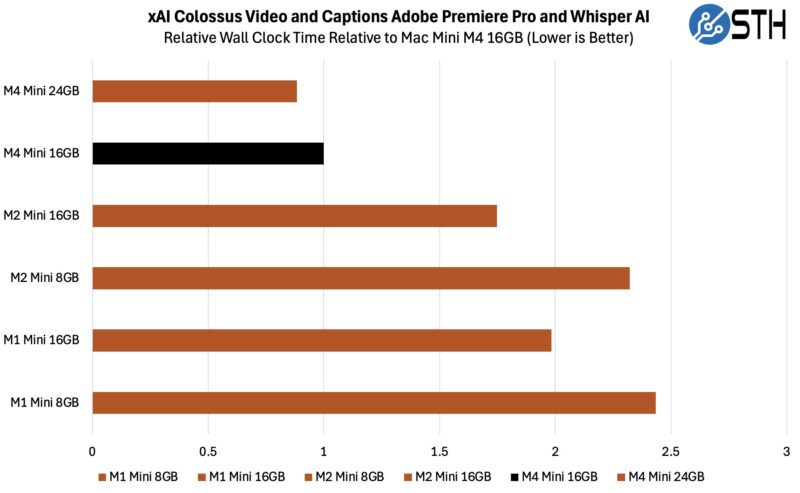
This is a really great example of where the M4 with 16GB or 24GB helped a lot.
On the M1 Max versus M4 Max side keeping memory capacity constant, we again saw a really nice speedup.
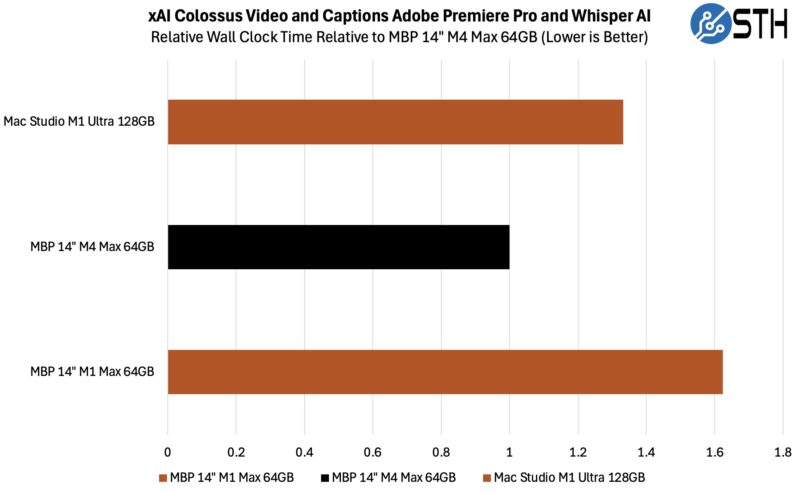
These may not seem like the most exciting workflows, but they are about as real as they get since they are just scripted versions of what we actually use to produce content. There are, of course, folks that do much more involved content creation, and different types of content creation. On the other hand, STH is on track to be a 1 million subscriber YouTube channel next year and the STH main site is still 4-5x bigger while the YouTube channel is around 750K subscribers. I think what we do is representative of content creation since that is what we do every day.
Networking Performance
The 1GbE Mac Mini M4 just kept its 1GbE connection saturated, but we had a few folks in Atlanta for Supercomputing 2024 last week tell us that the Mac Mini’s 10GbE was not a real 10GbE connection. We tried this over the MikroTik CRS304-4XG-IN to the QNAP TBS-h574TX 10GbE NAS:
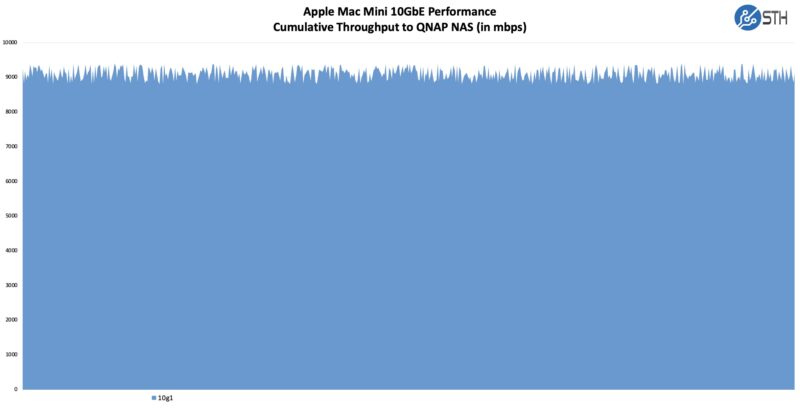
That appears to be 10GbE performance. Really though, that highlights how great the 10GbE upgrade is. Even for smaller networks, we have the small and inexpensive 10Gbase-T switches like that MikroTik. One can put a Mac Mini M4 10GbE, a 10GbE NAS like the QNAP or the TerraMaster F8-SSD Plus NAS, the Blacckmagic Design Cloud Pod for getting USB SSDs onto the 10GbE network, and still have another port for a router/ firewall like the iKoolCore R2 Max.
If you watch the video, you might also notice that we tried a 25GbE Thunderbolt dock with the unit.
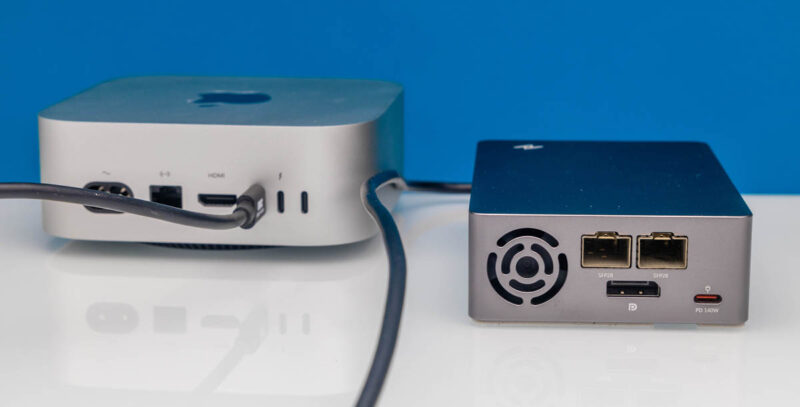
We bought this one on Kickstarter, it was quite delayed, and it is not available for order anymore, but hopefully others build something similar in the future. It only has the bandwidth to drive a single 25GbE SFP28 port, but the second port can be used with an adapter for 1GbE as well. If these are priced well, this type of device could be an answer for those who do not get 10GbE onboard.
Next, let us get to the power consumption.




That part about what good is a M1 8GB is very poignant today. Moreso what happens when Apple stops with updates? Is that M1 done unless you hack Linux onto it?
I do not agree with “The Apple Mac Mini M4 Sets the Mini Computer Standard”.
Mac Mini M4 is nothing special. It is classic Apple – design first(missing USB-A, power button on the bottom, (not)upgradable SSD,..)
…except the SSD actually is upgradable, with some disassembly pain.
Upgradable in the sense that you have to buy very specific modules made by someone if it isn’t torn from old systems
It’s not a normal M.2 either still
At the same time Strix Halo is coming which will certainly put a damper on Mx Pro/Max/Ultra sort of market
Apple will sell a few million Mac Minis. Less than 100 people will go through the pain of upgrading. They’re not upgradeable in the sense that PCs are.
@Dave
Not only it’s not M.2, but it’s not even a complete SSD. The removable module contains only NAND module(s) with no controller or RAM. That makes it even harder to source replacements for since the controller built into the motherboard supports only what Apple designed for in terms of NAND modules.
Good write-up. I saw a post a week ago on Twitter where a guy said the Mac Mini is the highest performing computer you can buy for under $600. Of course he also said the value proposition goes completely out the door if you upgrade anything on it.
Is the RaidenDigit 25 GbE Thunderbolt solution extinct? The webshop’s dead, the Kickstarter campaign off, no trace left …
The RaidenDigit 25 GbE Thunderbolt adapter looks awesome. I hope they survive. If the product is solid then it’s up to their sales & marketing or partners to bundle up 25Gb solutions for video editing companies, starting in Hollywood. 25 GbE is perfect for Thunderbolt 4 – that’s how you get network drives to reach speeds similar to local SSD.
The new Mac Mini is simply overpriced. Its expandability is severely limited, and once again, Apple relies on proprietary components to squeeze customers for every upgrade. This device is clearly aimed at those who either don’t care about the price or willingly submit to Apple’s pricing strategy.
Long-term investment? Doubtful. Once Apple ends support, this expensive piece of hardware will likely become little more than overpriced e-waste. A product that shines mainly when you’re ready to pay a premium for even the smallest upgrades.
Basically everything about Apple’s approach rubs me the wrong way; but it’s hard to deny the credibility that the really strong M-series part performance gives them basically by default.
I’m not lining up to pay those sorts of prices for soldered memory, functionally un-upgradeable storage, or expansion via PCIe cardcages that tend to cost more than whatever you are putting inside them; but one cannot deny how far up the stack you’ll need to go elsewhere to start at least trading shots with what Apple puts in the ‘meh, it’s the base model’ device.